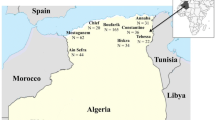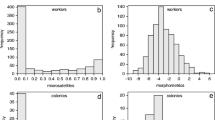Summary:
Seven microsatellite markers identified by probing clones made from a honeybee population from Victoria, Australia with a GA oligonucleotide are polymorphic in collections of honeybees from Iberia. Five of the microsatellites are GA repeats (three perfect repeats, two imperfect repeats, and one interrupted perfect repeat) of two others found in (GA)n-containing clones, one is a perfect AT repeat and one a mononucleotide T repeat. A further perfect GA repeat is monomorphic in the Iberian bees. Primer sequences are given for each of these microsatellites, and for seven others either not amplifying or giving multiple bands under the conditions used, or which were not tested. In all, eighteen microsatellites were found in twelve clones. One clone contained a minisatellite repeat, not assayed for polymorphism.
Similar content being viewed by others
Author information
Authors and Affiliations
Additional information
Received 16 February 1996; revised 22 October 1996; accepted 23 December 1996.
Rights and permissions
About this article
Cite this article
Rowe, D., Rinderer, T., Stelzer, J. et al. Seven polymorphic microsatellite loci in honeybees (Apis mellifera). Insectes soc. 44, 85–93 (1997). https://doi.org/10.1007/s000400050032
Issue Date:
DOI: https://doi.org/10.1007/s000400050032




